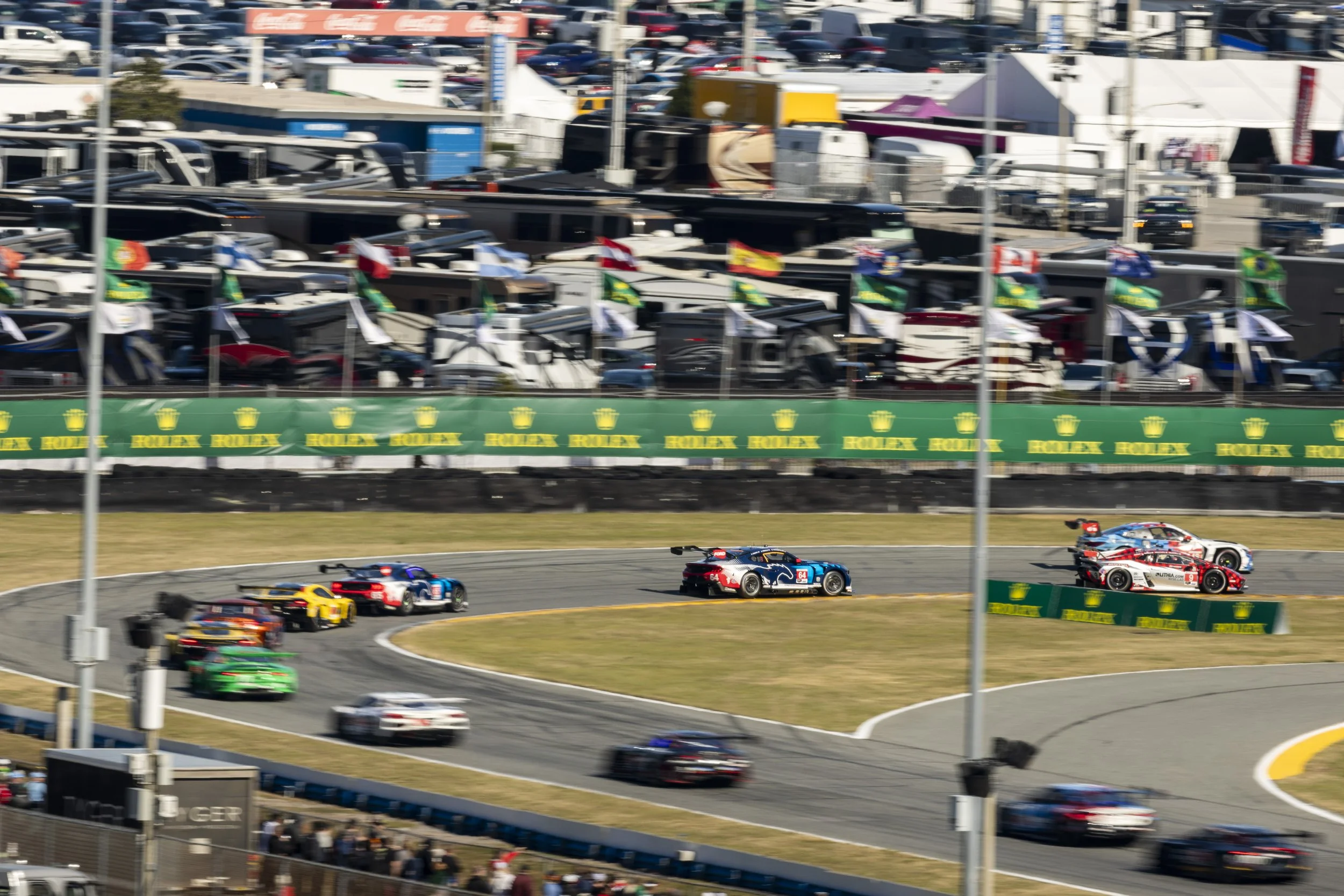Rolex 24 Hours of Daytona
Racing Against Time
A visit to the Rolex 24 Hours of Daytona transforms all perceptions of what it means to race against time. It’s apropos that for this extraordinary endurance race, winning drivers receive an engraved and coveted steel and yellow gold Rolex Oyster Perpetual Cosmograph Daytona, the ultimate timepiece inscribed with the word “Daytona” in red uppercase script.
On a Saturday afternoon in January, Daytona was unseasonably crisp, but the sky was clear. Elegant green and gold Rolex logos were on display everywhere at Daytona International Speedway. The Rolex 24 is the kickoff race to the motorsports season that forms the triple crown of endurance racing, along with the Twelve Hours of Sebring held in March and the 24 Hours of Le Mans in June.
I spent the day at the races with the Rolex Testimonees, accomplished drivers that serve as brand ambassadors in motorsports. Before the race, Hurley Haywood, who is the only driver to win Daytona five times, addressed my group. Haywood is an icon on and off the track and the subject of a Patrick Dempsey produced documentary. Haywood, who raced in the 1970s and ’80s for Porsche, said the sport has become infused by advances in driver technology since his heyday. He gave us insight to the challenge of racing after dark. “Cold tires on a track at night are recipe for disaster,” he said. Then we headed to the track where a pro-driver showed us the ins and outs of the Daytona speedway in a thrilling hot lap.
On Saturday afternoon, champion driver Jamie Chadwick, the honorary Grand Marshal, called out “Drivers start your engines!” through the loudspeaker. Chadwick is the most decorated woman driver in the world and will race in her first 24 Hours of Le Mans, a race that dates back to 1923. When later someone asked why Daytona is so important to drivers? “I think it's the watch,” she said with a knowing smile. As the grueling race commenced, legendary driver Tom Kristensen — who won the 24 Hours of Le Mans nine times between 1997 and 2013 — pulled on a headset to walk us through the ins and outs of a driver’s change in the pits. He explained how important it was for drivers to stay calm in the heat of the race. His Rolex commemorated his record number of wins and why he is known as “Mr. Le Mans.”
“I think it’s the watch”
To understand why the Swiss watch brand is a cornerstone at Daytona requires a bit of motorsport history. Rolex’s earliest watch, the Rolex Oyster, was developed for another form of endurance racing. In 1927, English swimmer Mercedes Gleitze swam for ten hours straight across the English Channel, firm proof that the Oyster was waterproof. A few years later, on the beaches of Daytona, the British racing driver Sir Malcolm Caldwell set land speed records in a car he called Bluebird. He was known to wear a Rolex Oyster during his runs. “I have now been using my Rolex Watch for a while, and it is keeping perfect time under somewhat strenuous conditions,” Caldwell once said. Among his many accolades, in 1932 he became the first man to exceed 250 miles per hour and he went on to break the land-speed record five times at Daytona.
When the speedway opened in 1959, Daytona became an international hub for motorsports — namely the NASCAR-sanctioned Daytona 500 that focuses on ovals and stock cars. Yet, even early on, endurance racing was baked into Daytona, as a section of the track was built to include an extended twisty course that spanned across 3.56 miles and looped into the infamous high embankment. When the first three-hour endurance race was held at Daytona in 1962, Dan Gurney, the winner, wore a Rolex Datejust. Rolex commemorated the race the following year with the introduction of its first Daytona watch, deemed Reference 6239, known as the Cosmograph, noted for its subdial and tachymeter scale engraved on the metal bezel. Paul Newman, who raced sports cars when he wasn’t starring in movies, brought star power to this watch, which he often flashed on his wrist. Through the years, endurance racing has attracted sports car fans. European brands are longtime contenders in this style of racing and still include factory teams supported by Porsche, BMW, and Ferrari.
For motorsports and watch fans, Daytona is legend, but over the past several years, a new generation is discovering motorsports and taking notice of the intersection of watches and fast cars. As interest in Formula 1 and the stars of the sport skyrockets, the appeal of other motorsports is growing. For new fans, it’s one thing to watch video of race cars zipping around Daytona, but another to catch part of this race up close and personal and feel the palpable sense of tension and drama in the air and to understand what makes this endurance race a mental and physical feat. Even without special access, fans can get up close to the field at Daytona, making it a worthwhile visit. The race is organized by the International Motor Sports Association (IMSA), a division of NASCAR, and is separate from the FIA World Endurance Championship (WEC) that organizes Le Mans. Keeping up with the players (and many acronyms) in motorsports can be daunting.
At its core, race car driving requires concentration, the ability to follow a precise line, and the courage to push harder, faster, and further. For the driver, sensations of desire, fear, and thrill ripple through the body with each turn in on the track to complete a lap at speeds up 200 miles per hour. Imagine cars weaving in and out of lanes, putting your life at stake to get ahead in a well-timed pass, and then staying the course to ward off challengers. Add in the element of sustained focus required from an over-caffeinated pit crew to plan exactly the right moment to adjust tires, add fuel, and swap drivers. Three separate drivers divide 24 hours of seat time in pursuit of a podium finish. Five different classes of cars compete in different categories on the same track, which adds to the delirium in the paddocks. It’s a lot to follow as 61 cars whiz by on the track, hour after hour. By dawn, its sheer will that propels these teams forward. The top series at Daytona, the grand touring prototypes, attracts the most attention for the fastest cars, but each series has its own unique culture and intersquad rivalries.
The thrill and the heartache of endurance motorsports is somewhat like life itself. It all comes down to timing and good fortune. Proof in point after 23 hours, a mishap caused the BMW M Hybrid V8 factory car to fall from metal contention to fifth place. The number 7 factory Porsche 963 helmed by drivers Felipe Nasr, Nick Tandy, and Laurens Vanthoor remained steady to the finish and earned the second consecutive Rolex 24 win for the Porsche Penske team.
After the race, the crowds rushed to victory lane, as the winning Porsche Penske car pulled in. The winning drivers hoisted the trophy and received their Rolex watches. The winners of the other series received their watches, too. The 24-hour long ordeal was over as champagne celebrations commenced. As Leo Tolstoy wrote in “War and Peace.” “The two most powerful warriors are patience and time.” The Rolex 24 is a thrilling spectacle of how human beings test the limits of these finite traits in the name of tradition.
Photography courtesy of Rolex.



















